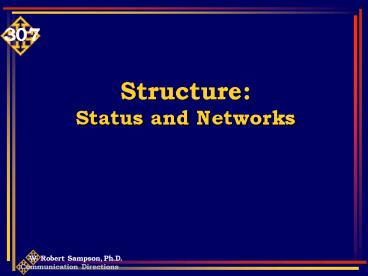Structure: Status and Networks - PowerPoint PPT Presentation
1 / 21
Title:
Structure: Status and Networks
Description:
The 'chain of command' or hierarchy of dominance ... Perfectionism. Emotion. Superiority attitude. Moodiness. Excessive analysis. Cautiousness ... – PowerPoint PPT presentation
Number of Views:48
Avg rating:3.0/5.0
Title: Structure: Status and Networks
1
Structure Status and Networks
2
Structure
- Norms
- Roles
- Status
- Networks
- Cohesiveness
3
Structure Interpersonal Relations
- Status
4
Structure Interpersonal RelationsStatus
Hierarchies
- Status Relations Stable distributions of power
or prestige within the group. The chain of
command or hierarchy of dominance - Status Differentiation the development of
authority relations within groups.
5
Structure Interpersonal RelationsClaiming
Status
- Those seeking high status are more likely to
- Tell other people what they should do
- Interpret other peoples statements
- Confirm or dispute others viewpoints
- Summarize or reflect on the discussion
- Status seekers use strong rather than weak
statements
6
Structure Interpersonal RelationsPerceiving
Status
- Group members intuitively take note of one
anothers status characteristicspersonal
qualities that they think are indicative of
ability or prestige.
7
Structure Interpersonal RelationsPerceiving
Status
- Specific-status characteristics are specific
behavioral and interpersonal characteristics that
group members take as evidence of ones ability
at the task to be performed in the given
situation - Which characteristics do you look for at the
beginning of a newly formed study group? - Which characteristics do you look for in planning
a major party or reception?
8
Structure Interpersonal RelationsPerceiving
Status
- Diffuse-status characteristics are general
qualities, such as sex and age, that group
members use to allocate status in groups - What general indicators do YOU use in estimating
the ability or prestige of others? - What general indicators indicate a lack of
prestige or ability?
9
Structure Interpersonal RelationsPerceiving
Status
- Diffuse-status characteristics are general
qualities, such as sex and age, that group
members use to allocate status in groups - Status generalization The tendency for
irrelevant, diffuse-status characteristics to
influence the status hierarchy in the group
10
Structure Interpersonal RelationsSocial
Standing
- Attraction relations patterns of liking and
disliking within a group - Sociometric differentiation the development of
patterns of liking and disliking in a group - Reciprocity and Transivity
- Clusters or cliques
11
Structure Interpersonal Relations
- Networks
12
Communication Networks
- A groups communication network may parallel
formally established paths, but most groups also
have an informal network that defines who speaks
to whom most frequently.
13
Communication Networks
The Chain -- Communication passes sequentially
from first to to last person .
14
Communication Networks
Centralized -- All communica-tion flows through
one member (the Y and wheel are examples)
15
Communication Networks
The Circle -- Communication flows sequentially
from first person to each member, but the circle
is completed.
16
Communication Networks
The Comcon -- Communication flows in all
directions
17
Communication Networks
- Centralized Networks are most efficient for
simple tasks. - Peripheral members are often dissatisfied within
such networks.
18
Communication Networks
- More information flows downward than upward in
hierarchical networks - In a hierarchical network, upward communication
that is sent upward is often unrealistically
positive.
19
What Drives You Crazy?
- Part 1
20
What Drives You Crazy?
- Incompetence
- Ingratitude
- Inefficiency
- Insensitivity
- Unreasonableness
- Lack of Cooperation
- Pessimism
- Restrictions
- Angry Outbursts
21
What Drives You Crazy?
- Incompetence
- Ingratitude
- Inefficiency
- Insensitivity
- Unreasonableness
- Lack of Cooperation
- Pessimism
- Restrictions
- Angry Outbursts
- Perfectionism
- Emotion
- Superiority attitude
- Moodiness
- Excessive analysis
- Cautiousness
- Talkativeness
- Aggressiveness
- Procrastination































